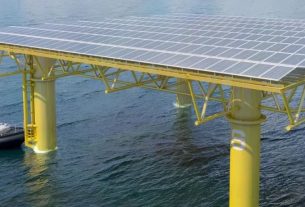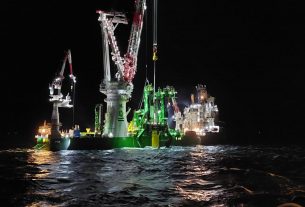Europe – According to WindEurope, floating offshore wind presents unique opportunities for Europe.
Floating turbines can generate power further offshore and in deeper waters than fixed turbines. As a result, offshore wind can now be developed in deeper sea basins such as the Mediterranean and Atlantic, even if the country does not have shallow waters.
Offshore wind that floats is rapidly growing in popularity. Currently, Europe has 113 MW of floating wind turbines in operation, with many more and larger floating wind farms in the works.
Hywind Tampen, the world’s largest floating wind farm, is currently under construction in Norway (88 MW). Within two years, France will have four small projects, each with a capacity of around 30 MW, up and running. Europe will have 330 MW of floating wind installed by 2024.
Then things will start to pick up significantly. The first of three auctions for large floating wind farms, each with a capacity of 250 MW, is currently underway in France. In the coming year, Spain, Greece, Portugal, and Norway all intend to launch large-scale auctions. Off the coasts of Sardinia, Apulia, and Sicily, several large floating projects are being developed. In addition, Scotland has granted seabed development rights for a massive 15 GW of floating projects this year.
Targets for 2030
All of this activity and ambition is reflected in floating wind targets for 2030, which have recently been announced by a number of countries. By that time, Greece wants 2 GW, Spain 1-3 GW, and the United Kingdom 5 GW. Italy is considering a 3.5 GW target for 2030. Portugal is planning to auction three sites, each capable of hosting two gigawatts of power. Ireland, meanwhile, has big plans for floating wind, though they are mostly for after 2030.
It is reasonable to expect that by 2030, Europe will have more than 10 GW of floating wind installed. However, goals do not always imply increased capacity. Governments require the appropriate policies and measures, which must be implemented in a timely manner.
They must first provide developers with clarity on where and how much they can build. Floating wind farm locations should be included in national Maritime Spatial Plans. Then governments require a clear auction schedule that specifies how much and when they will auction. These auctions should be focused on a specific technology. They should also provide revenue stability, preferably through index-linked 2-sided Contracts for Difference (CfDs).
Governments save money by using CfDs because they are repaid as well as paid out. They’re also cheap for society because they reduce financing costs – banks are content with the upfront capital requirements because they know they’ll be paid back because of the prospect of stable revenues.
The supply chain for floating wind will be distinct. Turbines are identical to those used in traditional (bottom-fixed) offshore wind farms. The floating structures on which the turbines are mounted are unique. These are large structures that must be put together in port and coastal areas. This necessitates significant investments in manufacturing facilities and infrastructure. Governments must make these investments easier to make and incentivize them. They must also ensure that grid connections are built on time and with the appropriate technology in order to connect floating structures to the grid.




